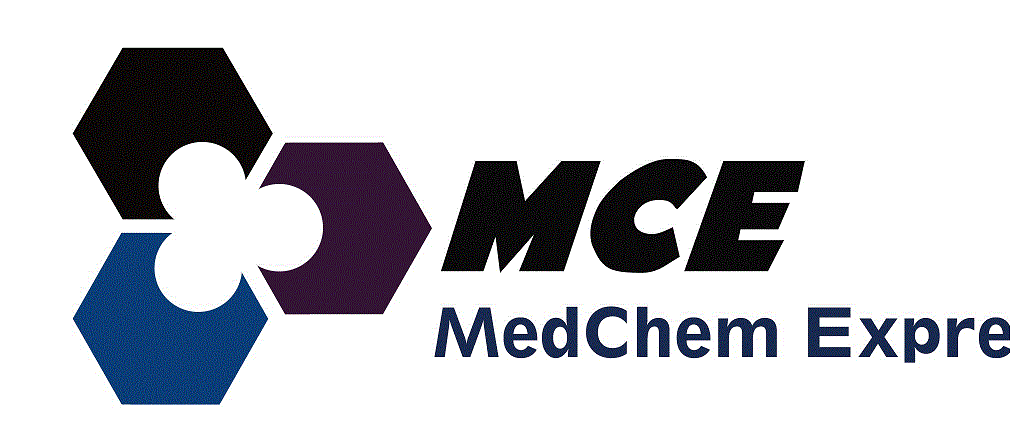MedChem Express
MedChem Express
δ-Theraphotoxin-Hm1a toxin is a selective Nav1.1 activator. δ-Theraphotoxin-Hm1a toxin elicits pain and touch sensitivity. δ-Theraphotoxin-Hm1a toxin can be used for the research of irritable bowel syndrome[1].
More Information
Supplier Page
MedChem Express
δ-Theraphotoxin-Hm1b is a 42-amino acid peptide isolated from Togo starburst tarantula (Heteroscodra maculata) venom. δ-Theraphotoxin-Hm1b selectively inhibits inactivation of NaV1.1 but have no effect on NaV1.7[1].
More Information
Supplier Page
MedChem Express
δ-Viniferin is a resveratrol dehydrodimer, an isomer of ε-Viniferin (HY-N3841)[1]. ε-Viniferin (epsilon-Viniferin), the dimer of Resveratrol, displays a potent inhibitory for all the CYP activities, with Ki values from 0.5-20 μM. ε-Viniferin possesses potent antioxidant, anti-inflammatory, anti-diabetic, and anti-neurodegenerative capacity.
More Information
Supplier Page
MedChem Express
Δ16-Dehydroadynerigenin β-D-digitaloside is a glycoside that can be isolated from the oven dried leaves of Nerium odorum. It is a heart-healthy component.
More Information
Supplier Page
MedChem Express
MedChem Express
MedChem Express
Epsilon-polylysine is an antimicrobial peptide that can be produced by bacteria such as Streptomyces. Epsilon-polylysine inhibits the growth of microorganisms such as bacteria, yeasts and molds and is therefore often used as a green food additive and preservative in various food and beverage products. Epsilon-polylysine has a variety of properties, including thermal stability, resistance to […]
More Information
Supplier Page
MedChem Express
ι-Carrageenan (Viscarin SD 309) is a biochemical reagent. ι-Carrageenan can be isolated from Eucheuma serra or red algae H. musciformis and S. filiformis. ι-Carrageenan has potential application in protein emulsion flocculation and stability[1][2][3][4].
More Information
Supplier Page
MedChem Express
κ-Bungarotoxin (κ-Bgt) is a potent, selective, and slowly reversible antagonist of α3β2 neuronal nicotinic acetylcholine receptors with an IC50 of 2.30 nM[1].
More Information
Supplier Page
MedChem Express
MedChem Express
κM-Conotoxin RIIIK is a potassium channel antagonist. κM-Conotoxin RIIIK can block voltage-activated potassium ion channels [1].
More Information
Supplier Page
MedChem Express
μ opioid receptor agonist 3 (compound 20) is a potent μ opioid receptor (µOR) agonist with an EC50 of 0.87 nM. μ opioid receptor agonist 3 has the potential for pain and neuropsychiatric indications research[1].
More Information
Supplier Page
MedChem Express
μ-Conotoxin BuIIIA (Mu-Conotoxin BuIIIA) is a voltage-gated sodium channel (VGSC) blocker. μ-Conotoxin BuIIIA is a toxic peptide that can be obtained from the venom of Cone snails. μ-Conotoxin BuIIIA can be used in the study of neurological diseases[1].
More Information
Supplier Page
MedChem Express
μ-Conotoxin BuIIIB (Mu-Conotoxin BuIIIB) is a mammalian neuronal voltage-gated sodium channel (VGSC) blocker. μ-Conotoxin BuIIIB can be obtained from the venom of Cone snails and is a probe for ion channel function research. μ-Conotoxin BuIIIB can be used in the study of neurological diseases such as pain[1].
More Information
Supplier Page
MedChem Express
MedChem Express
μ-Conotoxin GIIIB is a 22-residue polypeptide that can be isolated from the venom of piscivorous cone snail Conus geographus. μ-Conotoxin GIIIB is a NaV1.4 channel inhibitor. μ-Conotoxin GIIIB blocks muscle cell’s contraction[1][2][3].
More Information
Supplier Page
MedChem Express
μ-Conotoxin KIIIA is an analgesic μ-conotoxin that can be isolated from Conus kinoshitai. μ-Conotoxin KIIIA blocks mammalian neuronal voltage-gated sodium channels (VGSCs) (Nav1.2).μ-Conotoxin KIIIA can be used for research of pain[1][2].
More Information
Supplier Page
MedChem Express
μ-Conotoxin PIIIA is a sodium channel (NaV 1.4) blocker. μ-Conotoxin PIIIA can be isolated from Conus purpurascens[1][2].
More Information
Supplier Page
MedChem Express
μ-Conotoxin SIIIA is a tetrodotoxin (TTX)-resistant sodium channel blocker. μ-Conotoxin SIIIA is a toxic peptide that can be obtained from the venom of Conus snails. μ-Conotoxin SIIIA can be used in the study of neurological diseases, such as neuropathic pain[1].
More Information
Supplier Page
MedChem Express
MedChem Express
μ-Conotoxin SxIIIC is an irreversible NaV channel inhibitor that can be obtained from the Conus striolatus. μ-Conotoxin SxIIIC can be used in the study of neurological diseases such as chronic pain[1].
More Information
Supplier Page
MedChem Express
μ-Conotoxin-CnIIIC is a 22-residue conopeptide that can be isolated from Conus consors. μ-Conotoxin-CnIIIC is a potent and persistent blocker of NaV1.4 channel. μ-Conotoxin-CnIIIC has analgesic, anaesthetic and myorelaxant properties[1][2].
More Information
Supplier Page
MedChem Express
µ-Conotoxin-CnIIIC acetate, a 22-residue conopeptide, is a potent antagonist of the voltage-gated NaV1.4 sodium channel with an IC50 of 1.3 nM acting at the neuromuscular junction. µ-Conotoxin-CnIIIC acetate has myorelaxant and analgesic effects[1].
More Information
Supplier Page
MedChem Express
µ-Conotoxin-CnIIIC acetate, a 22-residue conopeptide, is a potent antagonist of the voltage-gated NaV1.4 sodium channel with an IC50 of 1.3 nM acting at the neuromuscular junction. µ-Conotoxin-CnIIIC acetate has myorelaxant and analgesic effects[1].
More Information
Supplier Page
MedChem Express
µ-Conotoxin-CnIIIC acetate, a 22-residue conopeptide, is a potent antagonist of the voltage-gated NaV1.4 sodium channel with an IC50 of 1.3 nM acting at the neuromuscular junction. µ-Conotoxin-CnIIIC acetate has myorelaxant and analgesic effects[1].
More Information
Supplier Page
MedChem Express
μ-TRTX-Hd1a, a spider venom, is a selective NaV 1.7 inhibitor. μ-TRTX-Hd1a is a gating modifier that inhibits human NaV 1.7 by interacting with the S3b-S4 paddle motif in channel domain II[1].
More Information
Supplier Page
MedChem Express
μ/κ/δ opioid receptor agonist 1 is a μ opioid receptor (MOR), κ opioid receptor (KOR), and δ opioid receptor (DOR) agonist. μ/κ/δ opioid receptor agonist 1 produces a strong and long-lasting analgesic effect through peripheral MOR and KOR in the tail-flick test[1].
More Information
Supplier Page
MedChem Express
π-TRTX-Hm3a is a 37-amino acid peptide isolated from Togo starburst tarantula (Heteroscodra maculata) venom. π-TRTX-Hm3a pH-dependently inhibits acid-sensing ion channel 1a (ASIC1a) with an IC50 of 1-2 nM and potentiates ASIC1b with an EC50 of 46.5 nM[1].
More Information
Supplier Page
MedChem Express
σ1 Receptor/μ Opioid receptor modulator 2 (compound 4x) is a dual μOR agonist/σ1R antagonist, and displays picomolar μOR agonism activity (EC50: 0.6 ± 0.2 nM) and good σ1R inhibitory activity (Ki: 363.7 ± 5.6 nM). σ1 Receptor/μ Opioid receptor modulator 2 exhibits robust analgesic effects in various pain models[1].
More Information
Supplier Page
MedChem Express
ω-Agatoxin IVA TFA is a potent, selective P/Q type Ca2+ (Cav2.1) channel blocker with IC50s of 2 nM and 90 nM for P-type and Q-type Ca2+ channels, respectively. ω-Agatoxin IVA TFA (IC50, 30-225 nM) inhibits glutamate exocytosis and calcium influx elicited by high potassium. ω-Agatoxin IVA TFA also blocks the high potassium-induced release of serotonin […]
More Information
Supplier Page
MedChem Express
ω-Agatoxin IVA TFA is a potent, selective P/Q type Ca2+ (Cav2.1) channel blocker with IC50s of 2 nM and 90 nM for P-type and Q-type Ca2+ channels, respectively. ω-Agatoxin IVA TFA (IC50, 30-225 nM) inhibits glutamate exocytosis and calcium influx elicited by high potassium. ω-Agatoxin IVA TFA also blocks the high potassium-induced release of serotonin […]
More Information
Supplier Page
MedChem Express
ω-Conotoxin Bu8 is a ω-conotoxin, which consists of 25 amino acid residues and three disulfide bridges. ω-Conotoxin Bu8 selectively and potently inhibits depolarization-activated Ba2+ currents mediated by rat CaV2.2 expressed in HEK293T cells (IC50= 89 nM)[1].
More Information
Supplier Page
MedChem Express
MedChem Express
MedChem Express
ω-Conotoxin CVIB is a non-selective N- and P/Q-type voltage-gated calcium channels (VGCCs) antagonist. ω-Conotoxin CVIB inhibits depolarization-activated whole-cell VGCC currents in dorsal root ganglion (DRG) neurons with a pIC50 of 7.64[1].
More Information
Supplier Page
MedChem Express
MedChem Express
MedChem Express
ω-Conotoxin CVIF is a selective Cav2.2 channel inhibitor with an IC50 of 34.3 nM in rat isolated DRG neurons. ω-Conotoxin CVIF block of Cav2.2 channels is weakly reversible[1].
More Information
Supplier Page
MedChem Express
ω-Conotoxin FVIA is an N-type Ca2+channel (Ca v 2.2) inhibitor. ω-Conotoxin FVIA reduces mechanical and thermal pain abnormalities in a rat model of caudal nerve injury. ω-Conotoxin FVIA can be used in the study of highly effective pain relievers with low side effects [1].
More Information
Supplier Page
MedChem Express
ω-conotoxin MoVIA is a potent and selective Cav2.2 inhibitor with an IC50 of 0.33 μM in SH-SY5Y fluorimetric hCav2.2 assay[1].
More Information
Supplier Page
MedChem Express
ω-Conotoxin MVIID (SNX-238) is a Conus peptide that blocks an ω-Conotoxin-GVIA-sensitive, high-threshold Ca2+ current in fish retinal ganglion cells[1].
More Information
Supplier Page
MedChem Express
ω-Conotoxin SO3 is a blocker of N-type voltage-sensitive calcium channel. ω-Conotoxin SO3 is an analgesicω-conotoxin that can be isolated from the venom of C. striatus[1][2].
More Information
Supplier Page
MedChem Express
ω-Grammotoxin SIA (GrTx) is P/Q and N-type voltage-gated Calcium channels inhibitor. ω-Grammotoxin SIA is also a protein toxin that can be obtained from spider venom. ω-Grammotoxin SIA has the potential to study neurological diseases as well as cardiovascular diseases[1].
More Information
Supplier Page
MedChem Express
ω-Hexatoxin-Hv1a is a neurotoxin that can be isolated from the venom spider (Hadronyche versuta).ω-Hexatoxin-Hv1a blocks voltage-gated calcium channels[1][2].
More Information
Supplier Page
MedChem Express
ω-Tbo-IT1 is a peptide toxin that can be isolated from the venom of Tibellus oblongus.ω-Tbo-IT1 is an inhibitor of insect calcium channel[1].
More Information
Supplier Page




